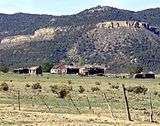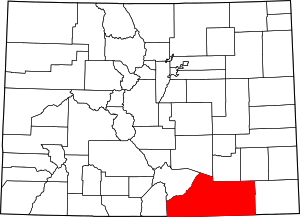Ludlow, Colorado
Ludlow is a ghost town in Las Animas County, Colorado, United States. It was famous as the site of the Ludlow Massacre–part of the Colorado Coalfield War–in 1914. The town site is nestled at the entrance to a canyon in the foothills of the Sangre de Cristo Mountains. It is located along the western side of Interstate 25 approximately 12 miles (19 km) north of the town of Trinidad. Nearby points of interest include the Ludlow Monument, a monument to the coal miners and their families who were killed in the 1914 massacre, the Hastings coke ovens, and the Victor American Hastings Mine Disaster Monument.
Ludlow | |
|---|---|
 Ludlow in 2013. | |
 Ludlow Location within the state of Colorado | |
| Coordinates: 37°20′00″N 104°34′59″W | |
| Country | United States |
| State | Colorado |
| County | Las Animas |
| Elevation | 6,283 ft (1,915 m) |
| Time zone | UTC-7 (Mountain (MST)) |
| • Summer (DST) | UTC-6 (MDT) |
| ZIP codes | 81055[1] |
| GNIS feature ID | 194575[2] |

Robert Adams made a series of photographs in Ludlow in 1981.[3] In June 2009, the Ludlow Tent Colony Site was dedicated as a National Historic Landmark by Department of the Interior in a ceremony attended by Governor Bill Ritter following approval in January of that year.[4]
Ludlow Massacre
On 20 April 1914, after months of sporadic violence and the withdrawal of a larger contingent of troops a few days before, Colorado National Guardsmen and local militia fired on strikers participating in the United Mine Workers of America strike against the Rockefeller-owned Colorado Fuel and Iron company. Roughly 20 occupants of the colony, including at least 12 women and children, were killed––mostly by smoke inhalation in the ensuing conflagration. Also among the dead was Greek labor-organizer Louis Tikas.[5] A single Guardsman is known to have been killed by gunfire from the strikers.[6] The violence at Ludlow sparked the most intense period of violence of the Colorado Coalfield War, which lasted until President Woodrow Wilson ordered troops into Colorado to end the fighting on 29 April.
References
- "Cuchara, CO ZIP Code - United States". codigo-postal.co. Retrieved 16 March 2020.
- "Ludlow, Colorado". Geographic Names Information System. United States Geological Survey. 13 October 1978. Retrieved 16 March 2020.
- Adams, Robert (1981). "Ludlow". Retrieved 7 February 2020.
- McPhee, Mike (27 June 2009). "Mining strike site in Ludlow gets feds' nod". The Denver Post. Retrieved 3 March 2020.
- "Water Tank Hill". The Colorado Coalfield War Archaeological Project. University of Denver. Retrieved 11 January 2020.
- Andrews, Thomas G. Killing for Coal: America's Deadliest Labor War. Cambridge, MA: Harvard University Press. ISBN 0-674-04691-9.
